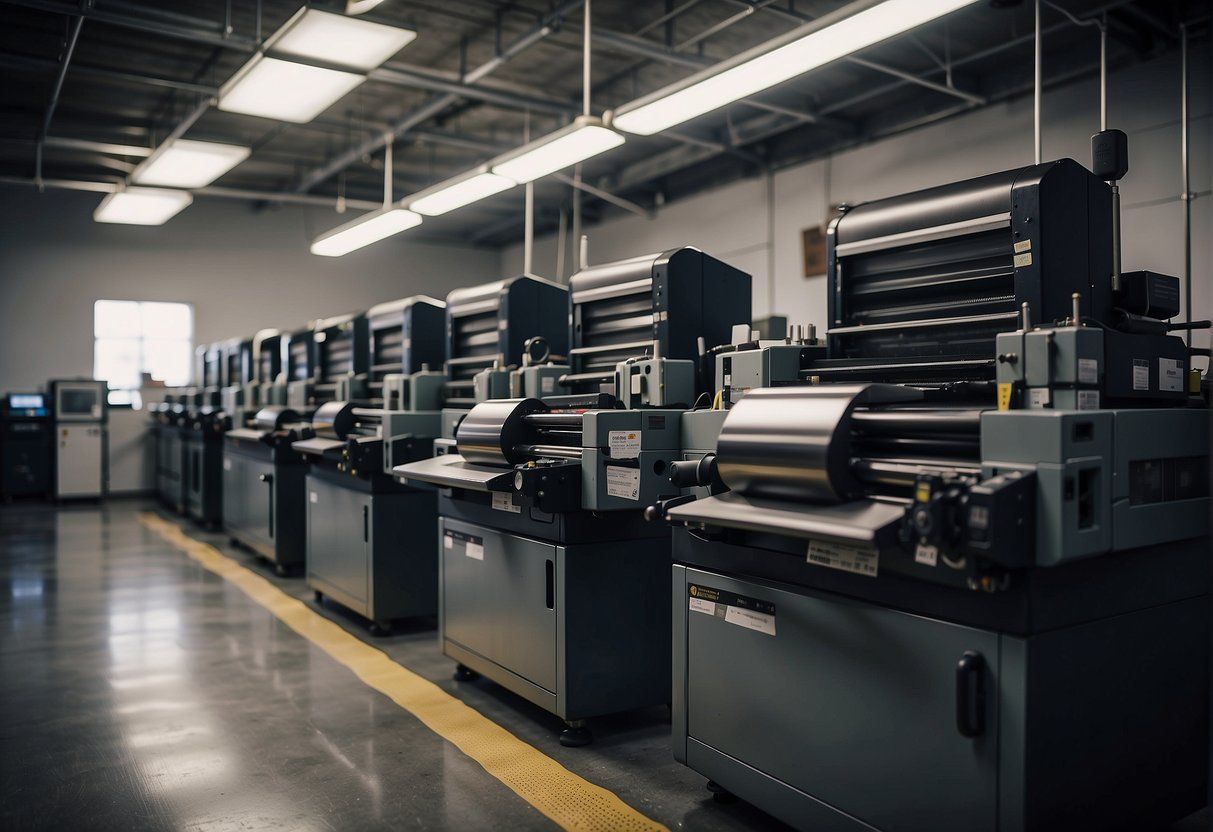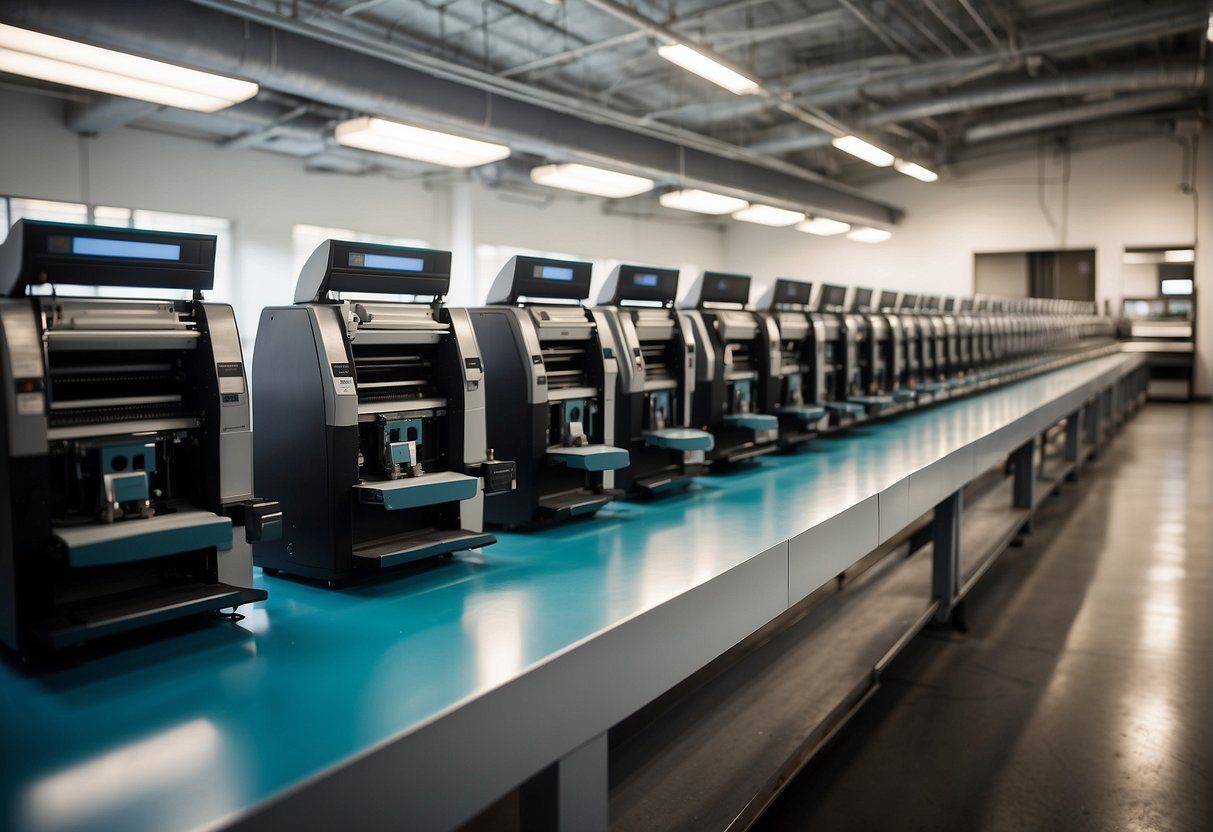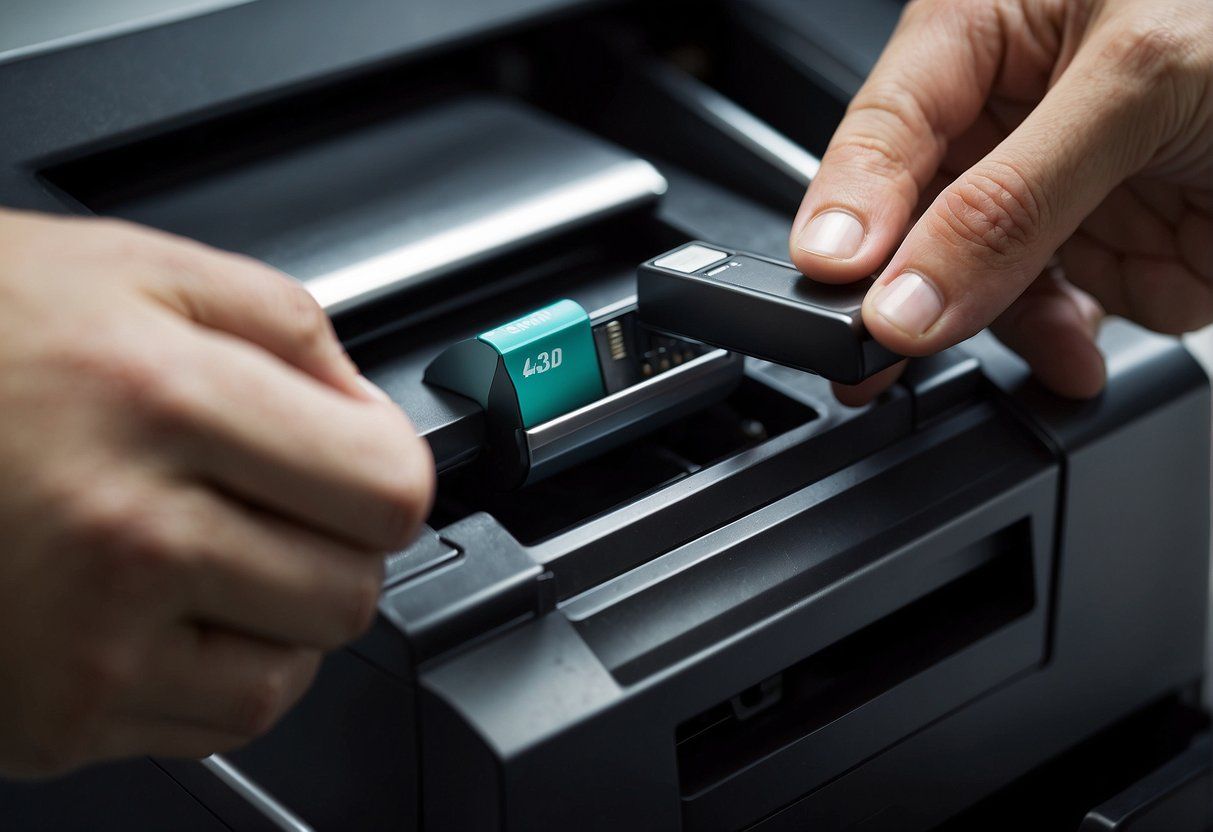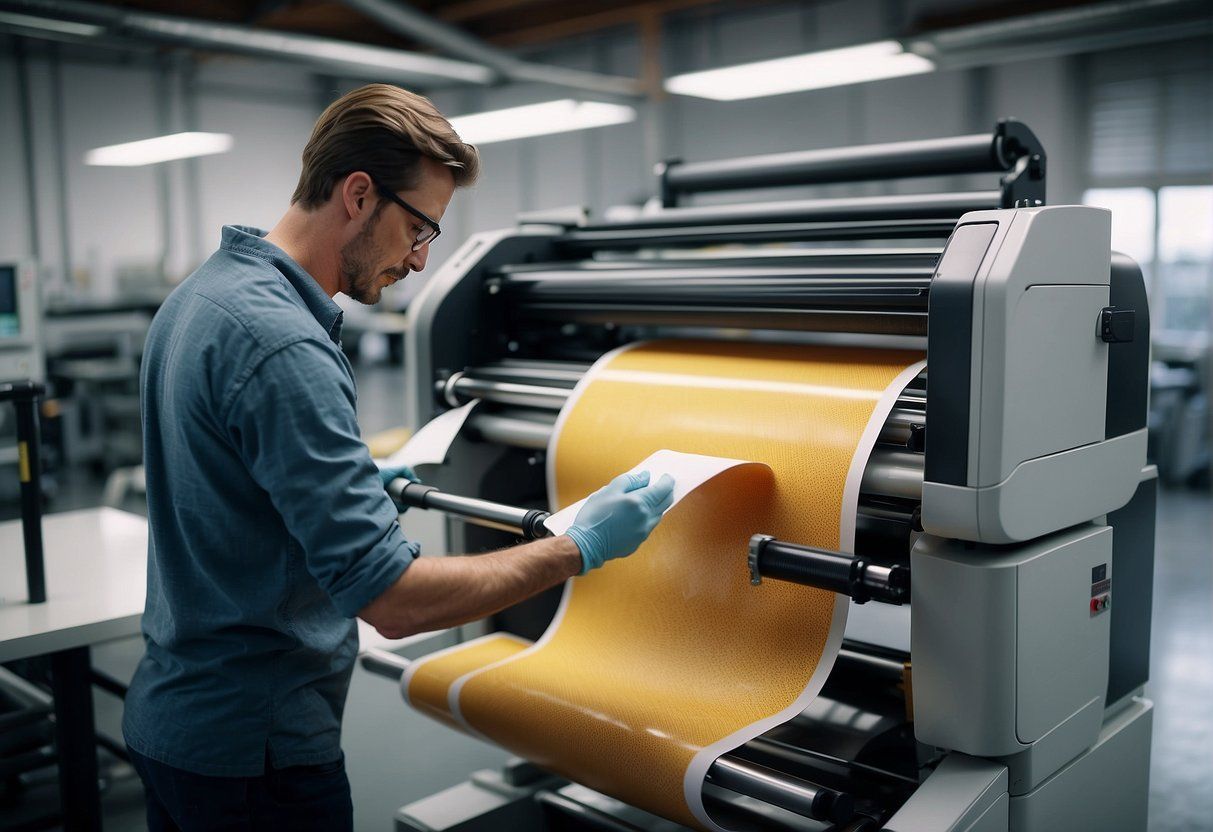Managing a print shop demands a comprehensive approach that blends creativity with efficiency. Accountability for every aspect from client order to final product delivery is critical, and leveraging the correct management techniques can result in a substantial increase in both productivity and customer satisfaction. Emphasis on strengthening customer service, streamlining workflow, and effectively managing inventory are keys to fostering a thriving print business environment.
Adoption of advanced software solutions, meanwhile, provides a solid backbone for operational efficiency in a print shop. Coupled with meticulous quality control and a continuous push towards improvement, these systems can help to ensure high standards are maintained throughout the production process. Strategic marketing and careful cost management further enhance the ability for a print shop to expand and grow sustainably in a competitive marketplace.
Key Takeaways
- Effective management of a print shop involves optimizing workflows and customer relations.
- Software platforms and quality control systems are essential for maintaining high production standards.
- Smart marketing and cost optimization contribute to sustainable growth and profitability.
Fundamentals of Print Shop Management
Managing a print shop involves overseeing various facets of the business to ensure efficiency and profitability. One of the primary components is productivity
, which can be quantified and monitored through key performance indicators (KPIs). These metrics help managers identify areas of success and those in need of improvement.
Technology Integration
Integrating advanced technology is essential for a modern print shop. Implementing state-of-the-art printing machinery and software solutions can streamline the print job
process from design to completion, improving the shop’s overall output.
Inventory Management
Effective inventory management ensures that a print shop has the required materials on hand without overstocking, thus preventing wastage and reducing costs. Categories often include paper, inks, and garments
, each tracked meticulously.
Financial Management
Financial management
covers everything from cash flow to the detailed analysis of expenses and revenues. Decisions based on financial data can lead to greater economic stability and growth potential for the business.
Maintenance and Continuous Improvement
Routine and proactive maintenance of equipment is vital, as it minimizes downtime and extends the lifespan of costly machinery. Alongside maintenance, a culture of continuous improvement—regularly evaluating and enhancing workflows and processes—helps a print shop to remain competitive in a rapidly evolving industry.
Following these fundamentals can establish solid foundations for the successful governance of print shops, aiding them in delivering high-quality products in a timely and cost-effective manner.
Workflow Optimization Techniques
The landscape of print services is on an evolutionary path toward more data-driven operations. One notable example includes the optimization of digital print workflow
which addresses due-dates, opportunity costs, and resource constraints
to enhance efficiency
.
A core component of workflow optimization is the use of technology
to identify and eliminate bottlenecks
in the production process. Implementing software
solutions facilitates real-time job tracking
, allowing for a fluid and responsive approach to work orders
. As seen in this study on digital print workflow
, mixed-integer linear programming (MILP) can be used for job shop production optimization.
| Key Focus Area |
Implementation Strategy |
| Work Order Management |
Employ digital systems to generate and track orders efficiently. |
| Bottleneck Resolution |
Analyze production data to find and address inefficiencies. |
| Automation |
Integrate automated machinery where possible to streamline tasks. |
In addition, implementing
tailored strategies, like genetic algorithms (GAs), as discovered in real-time and online digital print factory workflow
, can adaptively enhance productivity, offering dynamic solutions to complex scheduling challenges. To properly manage work orders and aid in smooth operations, businesses must also invest in effective workflow management systems
, such as those described in Workflow management: models, methods, and systems
, to maintain a “one-stop shopping” approach to accessing various informational resources and services.
The process of workflow optimization is iterative and should be informed by ongoing data analysis and regular reviews of the production process. With these techniques, print shops can establish a more predictable, effective, and profitable operation.
Software Solutions for Print Shop Efficiency
Software solutions have become pivotal in enhancing efficiency within print shops. From streamlining workflow to managing jobs and finances, the adoption of robust software platforms is transforming print shop operations.
Shop Management Software Integration
Integrating shop management software
such as Printavo can significantly improve operational workflow. This technology facilitates real-time job tracking, simplifies communication channels, and enables more consistent task allocation. For print shops, the software serves as a centralized system, managing everything from quotes to invoicing, helping to boost overall production efficiency. An example of these advantages can be seen in the design of a task management system
based on queuing algorithms, which optimizes task assignments to prevent bottlenecks.
Accounting and Job Tracking Systems
Effective accounting software is critical for financial oversight and resource management in print shops. These systems not only track expenses and revenues with high accuracy but also provide valuable insights into financial health. Additionally, job tracking systems ensure all print jobs are monitored from inception to delivery, ensuring deadlines are met and quality is maintained. A comparative study showcasing the effectiveness of such systems is highlighted in the implementation of a cloud-based printing order management system
, demonstrating the importance of integrating customers into the production process for enhanced efficiency.
Improving Customer Service and Relationships
Effective print shop management hinges on robust customer service and nurturing long-term customer relationships. These aspects directly influence repeat business and word-of-mouth referrals, vital for sustained growth. Strengthening these areas involves strategic communication and leveraging customer relationship management systems.
Communication Strategies
Communication is the lifeblood of customer satisfaction in any print shop. It is crucial to ensure that the sales team
and customer service representatives engage with customers promptly and professionally. They should employ a variety of channels — such as email, phone, and in-person consultations — to accommodate different customer preferences. Additionally, it’s important to provide clear, concise information about services and to follow up on orders and feedback. For instance:
- Email confirmations for received orders with detailed invoices.
- Phone calls to address any customer concerns or queries.
- Regular updates on the progress of ongoing projects.
Good communication also involves training staff to actively listen
to customers, ensuring that their needs are understood and met.
Customer Relationship Management
Customer Relationship Management (CRM)
tools are integral in tracking interactions and history with customers. They facilitate a more personalized approach to service, where the sales team
can identify opportunities tailored to individual clients. By using a CRM, a print shop can:
- Maintain detailed records of each customer interaction.
- Analyze customer data to improve service offerings.
- Create targeted marketing campaigns that boost sales via informed upselling.
By continuously optimizing communication
and customer service
through strategic use of CRM
, print shops can create strong customer relationships
that are essential for repeat business and sustained success.
Sales and Revenue Enhancement
To enhance sales and revenue for a print shop, it is essential to develop a comprehensive sales strategy and engage in meticulous financial planning and management. These two areas are critical for improving profitability and maintaining a healthy cash flow.
Developing a Sales Strategy
In crafting a sales strategy
, the focus should be on identifying and cultivating the sales base. Strategies may involve differentiating services
, such as offering online photo-printing or custom greeting cards, to build a unique value proposition. A concerted effort to train the sales team on these services ensures they can effectively communicate the benefits, resulting in increased sales and subsequently, revenue. For instance, a sales pitch might center on the cost savings a customer would enjoy from a new line of eco-friendly print materials, influencing both sales and customer satisfaction.
Financial Planning and Management
Effective financial planning and management
are pivotal in ensuring that efforts to boost revenue also lead to increased profits. This process includes analyzing the financial impact of revenue enhancement measures to confirm that they will indeed lead to the desired outcomes. Measures might include the adoption of environmentally friendly technologies that not only reduce waste but can also serve as a selling point to customers, potentially leading to revenue growth. Meanwhile, close monitoring of the financial health of the print shop allows for timely adjustments in strategy, safeguarding both profitability and cash flow.
Inventory and Resource Management
Efficient inventory and resource management is crucial in the printing industry, ensuring the right materials are available in the correct quantities and specifications. These resources range from various paper sizes and types to a spectrum of inks, including specific Pantone colors.
Inventory Control
Inventory control in a print shop involves meticulous tracking of resources such as paper stock, ink levels, and other printing materials. A balance is maintained to avoid excess that could lead to waste or too little that could result in delays. Print shops utilize Enterprise Resource Planning (ERP)
systems for real-time inventory monitoring, aligning with a study on integrating ERP systems in the printing industry.
- Paper Inventory
: It is categorized by sizes
and qualities
. Regular audits are conducted to ensure the availability of frequently used sizes like A4 or letter and specialty sizes for custom orders.
- Example
: Regular stock | Specialty stock
- A4: 5000 sheets | A2: 500 sheets
- Ink Inventory
: Managing ink involves tracking quantities and the types of inks on hand, focusing on standard CMYK inks and specific Pantone colors
to meet customer demands.
- Example
: Ink Type | Quantity
- CMYK: 10 liters each | Pantone 185 C: 2 liters
- Resource Allocation
: Resources are carefully allocated to jobs, ensuring that materials are reserved for upcoming projects. Job sheets detail the required colors
and quantities
for each order.
- Example Allocation
:
- Job 101: 250gsm gloss paper, CMYK inks
- Job 102: 150gsm matte paper, Pantone 286 C
Production Efficiency and Continuous Improvement
Fostering production efficiency and continuous improvement in print shops is central to staying competitive. These efforts are designed to elevate productivity, minimize waste, and streamline processes using strategies like the Toyota Production System.
Implementing Lean Methodologies
Lean methodologies are essential tools that print shops can integrate to enhance operational efficiency. They focus on value creation for the customer
with fewer resources by systematically reducing non-value-adding activities (waste). The core lean principle is to produce what is needed, when it is needed
. By adopting elements such as Just-In-Time
(JIT) production, processes are refined to produce only the amount required to fulfill the immediate demand, which minimizes inventory costs and waste.
For example, the ‘Theory and Practice of Continuous Improvement in Shop-floor Teams’ suggests a clear connection between continuous improvement and an organization’s effectiveness. Tools like value stream mapping
can help identify bottlenecks and areas of waste to be targeted for improvement.
Maintenance and Downtime Reduction
Proactive maintenance plays a significant role in ensuring print shop machinery operates at peak efficiency. A focus on predictive and preventive maintenance
reduces unexpected downtime, thereby improving productive hours and throughput. Employing a regular maintenance schedule ensures equipment reliability and longevity, contributing to the overall equipment effectiveness (OEE) – a critical metric in continuous improvement strategies.
Print management systems are integrated to track the performance
of machines and enable data-driven decisions. This approach reduces equipment failure and helps in sustaining a culture of process control and continuous improvement — as advocated by ‘The Roadmap for Efficiency and Operational Excellence’. Shops using these strategies effectively reduce the chances of downtimes that might interrupt the workflow and lead to waste, be it time or resources.
Quality Control and Output Management
Effective management in any print shop requires rigorous quality control and efficient output management. Quality control
(QC) is paramount as it ensures that the final product meets or exceeds customer expectations. In the context of screen printing
on garments
, QC involves a thorough inspection of each item for ink consistency, proper color matching, and the absence of smudges or misprints.
Output management
focuses on streamlining production workflow, emphasizing the prioritization of tasks to meet deadlines without compromising quality. It is essential to set clear, measurable metrics
to evaluate the performance of both processes and personnel involved.
- Inspection at every stage
- Standardized QC protocols
- Regular equipment maintenance
- Training for technical skill improvement
| Stage |
Quality Check Focus |
| Pre-print |
Artwork accuracy, screen tension |
| Printing |
Color fidelity, registration |
| Post-print |
Ink curing, finishing
quality |
Prioritization
plays a critical role, especially when dealing with a high volume of orders. Print shops need a system to manage job queues efficiently—prioritizing based on delivery times, complexity, and resource availability.
By maintaining a balance between high-quality outputs and timely delivery, print shops can establish a reputation for excellence and reliability. They must invest in quality materials, stay up-to-date with industry standards, and continuously refine their QC and output management processes.
Growth and Expansion Strategies
Expanding a print business
requires a strategic approach that leverages both current capabilities and future opportunities. Print shop owners aiming for growth can consider the following methods:
1. Investing in Technology:
Advancements in digital printing offer a competitive edge. By adopting new technologies
, they can enhance efficiency, reduce waste, and diversify service offerings.
2. Staff Training:
Continuous skills development ensures a workforce that can adapt to new technologies and optimize operations. Prioritizing ICT skills
is essential for streamlining workflows and embracing digital transformation.
3. Diversifying Services:
Incorporating a variety of printing methods, such as screen printing
, caters to a wider market and encourages repeat business from clients seeking multiple services.
4. Partnerships and Alliances:
Forming strategic partnerships can lead to mutual growth. Print shops can collaborate with artists, designers, and agencies to tap into new customer segments.
| Strategy |
Description |
Outcome |
| Technology Investment |
Upgrading to latest print technologies. |
Enhanced efficiency, new markets |
| Workforce Development |
Focusing on training in emerging print management techniques. |
Skilled, adaptable team |
| Service Diversification |
Offering a broader range of printing options. |
Wider customer base |
| Strategic Partnerships |
Collaborating with relevant businesses and professionals. |
Access to new markets |
By implementing such strategies, a print shop
can set itself on a growth trajectory, ensuring its relevance and profitability in an evolving industry.
Workplace Organization and Management
Effective print shop management hinges on meticulous organization and operational efficiency. This section elaborates on strategies that ensure a clutter-free environment, a systematic approach to organization, and the significance of expert guidance for empowering the workforce.
Minimizing Clutter and Maximize Space Utilization
In print shop environments, managing clutter is paramount. It is best to adopt a lean management approach
, often derived from Taiichi Ohno’s principles, which advocates for the elimination of non-value-adding components. By utilizing vertical storage systems
and modular furniture
, print shops can make the most of available space. Additionally, designating specific areas for different tasks and maintaining clear pathways can significantly enhance spatial efficiency and safety.
Labeling and Systematic Organization
Systematic organization is facilitated through clear labeling. By employing a consistent labeling system
, employees can locate tools, materials, and documents swiftly, reducing downtime. Use of color-coding and alphanumeric systems enhances this process, streamlining operations in the print shop. Such organization also supports Bruce Ackerman’s views on the necessity of a well-structured vocabulary that defines locations and procedures within the workspace.
Expert Guidance and Training
Leveraging the expertise of industry veterans and structured training programs can catapult a print shop’s productivity and quality. Cross-functional training, as mentioned in the research on print management
, is essential for skill improvement. Training that emphasizes workplace organization, machine operation, and management systems, not only builds a capable team but also instills a culture of continuous improvement essential for thriving in a competitive market.
Cost Management and Optimization
Effective cost management and optimization in print shops revolves around controlling expenses, enhancing efficiency, and maximizing profits. By focusing on reducing labor costs and negotiating with vendors and suppliers, print shops can significantly lower their production costs and improve their bottom line.
Reducing Labor Costs
Labor is often one of the largest expenses for print shops. It is imperative to evaluate the efficiency of the workflow and identify areas where automation can streamline processes. Implementing solutions from the realm of digital print workflow optimization
can lead to significant labor savings. Additionally, closely monitoring and improving key performance indicators (KPIs) related to employee performance can pinpoint opportunities for further cost reductions. Cross-training employees is another strategy, thus ensuring a versatile workforce capable of managing multiple tasks effectively, thereby reducing dependency on specialized staff.
Negotiating with Vendors and Suppliers
Materials and supplies represent a substantial cost for print shops. It’s crucial to regularly reassess contracts and seek out more favorable terms with suppliers. Bulk purchasing often leads to better pricing, but it is essential to balance volume buying with the risk of excess waste due to spoilage or obsolescence. To avoid unnecessary expenditures, one must also evaluate the total cost of ownership when selecting new equipment or materials, considering factors like maintenance, longevity, and consumable usage over time. A strategic partnership with vendors can aid in aligning efforts towards cost optimization and waste reduction through just-in-time inventory practices, which can be informed by insights such as those offered in a study on assortment-quantity optimization problems using simulation modelling.
Marketing and Branding for Print Shops
Effective print shop management
requires a strategic approach to marketing
and branding
. Print shops should craft a unique brand identity that resonates with their target audience. This can be established by developing a strong logo, consistent color schemes, and a professional image that is conveyed across all printed materials, such as business cards, brochures, and signage.
- Create a distinct logo
that is easily recognizable.
- Implement a consistent visual style
across all materials.
When it comes to marketing, print shops should utilize both traditional and digital channels to reach customers. Traditional methods include direct mail campaigns and local advertisements. For digital marketing, an online presence is essential. This includes a user-friendly website, search engine optimization (SEO), and active social media engagement to drive traffic and foster community.
- Utilize direct mail
for targeted local ads.
- Establish an SEO-optimized
website to attract online traffic.
- Engage with customers through social media
platforms.
Leveraging customer relationships is also vital. Offering personalized services and fostering strong customer relationships can lead to word-of-mouth referrals, which are invaluable for local businesses.
- Offer customization options
for print products.
- Provide exceptional customer service
to encourage referrals.
Finally, it is important for print shops to understand their market. Conducting market research can help identify the demands of local businesses and consumers. Tailoring services to meet these needs can set a print shop apart from its competitors.
- Perform research to understand customer needs.
- Tailor services
to meet market demands.
Adopting New Technologies and Trends
In the dynamic realm of print media, embracing innovative technologies
is critical for print shops aiming to remain competitive. Staying abreast of emerging trends
involves not just adopting new machinery but also integrating advanced production methods and strategies. Digital print production has become particularly paramount, as highlighted by the drastic shift towards digitalization across various market segments.
Print shops that integrate novel printing technologies
, such as 3D printing and automation, can achieve improved efficiency and customization. It is not only about acquiring new hardware but also about tweaking management workflows to optimize these technologies. Companies must evaluate the cost-benefit ratio
and seek expert advice
to ensure a smooth transition.
Adoption strategies may include:
- Training staff to operate new systems effectively.
- Regularly updating software to leverage the full array of functionalities.
- Analyzing market data to anticipate client demands.
Forward-thinking print shops are also turning to online platforms, recognizing the significant role of the Internet in consumer behavior. The adoption of online printing services
can enhance client satisfaction by providing convenient and rapid service options.
Investing in new technologies and trends
is not just a matter of staying relevant, but it is pivotal in unlocking new opportunities and driving business growth. Print shops that successfully adopt and leverage these advancements are more likely to lead in innovation and customer satisfaction.
Legal and Ethical Considerations
In managing a print shop, one must navigate both legal and ethical landscapes with due diligence. Legally, compliance with copyright laws is non-negotiable. Print shops must ensure that content reproduced is properly licensed
or falls within the public domain. They similarly need to adhere to standards set by the ACA ethical standards casebook
, which integrate ethical considerations into legal frameworks.
From an ethical standpoint, print shops should consider the implications of their work on society and corporate social responsibility. Practices should be transparent and fair, not only to comply with legal requirements but to uphold integrity in business dealings. The following table outlines key points of attention:
| Legal Obligations
|
Ethical Duties
|
| Copyright adherence |
Honesty in reproduction |
| Data privacy regulations |
Respect for client confidentiality |
| Employment and labor laws |
Fair treatment of employees |
| Environmental regulations |
Sustainable environmental practices |
Print shop managers face ethical dilemmas that extend beyond the law. For instance, the decision to print material that may be deemed offensive or sensitive can evoke ethical questions. They must balance societal impact with free speech rights, often referencing ethical frameworks like those found in the literature on pedagogic cacophony
regarding advertising education’s moral reasoning.
Ultimately, print shop management requires a blend of legal knowledge and ethical sensibility. Adhering to both sets of principles not only protects the business legally but also fosters trust and a strong reputation among its clientele and the wider community.
Frequently Asked Questions
In managing a print shop, one encounters numerous questions regarding efficiency, client relations, inventory control, technological advancements, quality assurance, and team training. Addressing these aspects can significantly enhance the operational effectiveness of a print shop.
What strategies can improve print shop productivity?
In pursuit of increased productivity, print shops can adopt scheduling strategies and scale operations
efficiently. Streamlining workflows and reducing idle machine time are critical in achieving better output.
How can a print shop manager effectively handle client relationships?
Effective client relationship management involves clear communication, understanding client needs, and delivering on promises. Implementing a systematic approach to tracking orders and feedback ensures clients’ expectations are met and trust is built.
What are the best practices for inventory management in a print shop?
For inventory management, maintaining an optimal stock level to meet demand without overstocking is vital. Utilizing inventory management software can aid in monitoring supply levels
and track usage patterns to predict future needs.
In what ways can technology be leveraged to enhance print shop operations?
Technology can revolutionize a print shop by introducing 3D printing services
or incorporating digital management systems. Upgrading to the latest printing technology ensures high-quality output and efficiency.
How important is quality control in print production, and how can it be maintained?
Quality control is paramount in print production as it guarantees customer satisfaction and repeat business. Regular maintenance of equipment, adherence to production standards, and staff training in quality assurance processes are essential to maintain high-quality standards.
What training or development opportunities should a print shop manager provide to their team?
A print shop manager should prioritize training in new printing techniques, customer service, and software utilization. Encouraging staff to attend workshops and industry conferences can lead to skill enhancement and higher levels of service excellence.…














